Assessing Inequitable Urban Heat Islands and Air Pollution Disparities with Low-Cost Sensors in Richmond, Virginia
Abstract
1. Introduction
2. Materials and Methods
2.1. Study Area
2.2. Sampling Approach
2.3. Analysis of Spatial and Temporal Patterns
3. Results
3.1. Spatial Variability in Urban Temperatures
3.2. Connections between Urban Temperatures and Air Quality
3.3. Diurnal Patterns in Urban Air Quality
3.4. Spatial Patterns in Urban Air Quality
4. Discussion
Author Contributions
Funding
Acknowledgments
Conflicts of Interest
References
- Bowatte, G.; Lodge, C.; Lowe, A.J.; Erbas, B.; Perret, J.; Abramson, M.J.; Matheson, M.; Dharmage, S.C. The influence of childhood traffic-related air pollution exposure on asthma, allergy and sensitization: A systematic review and a meta-analysis of birth cohort studies. Allergy 2015, 70, 245–256. [Google Scholar] [CrossRef]
- Gehring, U.; Wijga, A.H.; Brauer, M.; Fischer, P.; De Jongste, J.C.; Kerkhof, M.; Oldenwening, M.; Smit, H.A.; Brunekreef, B. Traffic-related Air Pollution and the Development of Asthma and Allergies during the First 8 Years of Life. Am. J. Respir. Crit. Care Med. 2010, 181, 596–603. [Google Scholar] [CrossRef]
- Dockery, D.W.; Pope, C.A.; Xu, X.; Spengler, J.D.; Ware, J.H.; Fay, M.E.; Ferris, B.G.; Speizer, F.E. An Association between Air Pollution and Mortality in Six U.S. Cities. N. Engl. J. Med. 1993, 329, 1753–1759. [Google Scholar] [CrossRef]
- Wu, X.; Nethery, R.C.; Sabath, B.M.; Braun, D.; Dominici, F. Air pollution and COVID-19 mortality in the United States: Strengths and limitations of an ecological regression analysis. Sci. Adv. 2020, 6, eabd4049. [Google Scholar] [CrossRef]
- Grove, M.; Ogden, L.; Pickett, S.; Boone, C.; Buckley, G.; Locke, D.H.; Lord, C.; Hall, B. The Legacy Effect: Understanding How Segregation and Environmental Injustice Unfold over Time in Baltimore. Ann. Am. Assoc. Geogr. 2018, 108, 524–537. [Google Scholar] [CrossRef]
- Mohai, P.; Lantz, P.M.; Morenoff, J.; House, J.S.; Mero, R.P. Racial and Socioeconomic Disparities in Residential Proximity to Polluting Industrial Facilities: Evidence From the Americans’ Changing Lives Study. Am. J. Public Health 2009, 99, S649–S656. [Google Scholar] [CrossRef]
- Mikati, I.; Benson, A.F.; Luben, T.J.; Sacks, J.D.; Richmond-Bryant, J. Disparities in Distribution of Particulate Matter Emission Sources by Race and Poverty Status. Am. J. Public Health 2018, 108, 480–485. [Google Scholar] [CrossRef]
- Fumes across the Fence-Line: The Health Impacts of Air Pollution from Oil & Gas Facilities on African American Communities. NAACP & CATF. 2017. Available online: https://bit.ly/2K632jW (accessed on 12 May 2020).
- King, K.E. Chicago residents’ perceptions of air quality: Objective pollution, the built environment, and neighborhood stigma theory. Popul. Environ. 2015, 37, 1–21. [Google Scholar] [CrossRef]
- Finley-Brook, M.; Williams, T.L.; Caron-Sheppard, J.A.; Jaromin, M.K. Critical energy justice in US natural gas infrastructuring. Energy Res. Soc. Sci. 2018, 41, 176–190. [Google Scholar] [CrossRef]
- Sachindra, D.A.; Ng, A.; Muthukumaran, S.; Perera, B.J.C. Impact of climate change on urban heat island effect and extreme temperatures: A case-study. Q. J. R. Meteorol. Soc. 2015, 142, 172–186. [Google Scholar] [CrossRef]
- Connors, J.P.; Galletti, C.S.; Chow, W.T.L. Landscape configuration and urban heat island effects: Assessing the relationship between landscape characteristics and land surface temperature in Phoenix, Arizona. Landsc. Ecol. 2013, 28, 271–283. [Google Scholar] [CrossRef]
- Vargo, J.; Stone, B.; Habeeb, D.; Liu, P.; Russell, A. The social and spatial distribution of temperature-related health impacts from urban heat island reduction policies. Environ. Sci. Policy 2016, 66, 366–374. [Google Scholar] [CrossRef]
- Shandas, V.; Voelkel, J.; Williams, J.; Hoffman, J. Integrating Satellite and Ground Measurements for Predicting Locations of Extreme Urban Heat. Climate 2019, 7, 5. [Google Scholar] [CrossRef]
- Tan, J.; Zheng, Y.; Tang, X.; Guo, C.; Li, L.; Song, G.; Zhen, X.; Yuan, D.; Kalkstein, A.J.; Li, F.; et al. The urban heat island and its impact on heat waves and human health in Shanghai. Int. J. Biometeorol. 2010, 54, 75–84. [Google Scholar] [CrossRef]
- Voelkel, J.; Hellman, D.; Sakuma, R.; Shandas, V. Assessing Vulnerability to Urban Heat: A Study of Disproportionate Heat Exposure and Access to Refuge by Socio-Demographic Status in Portland, Oregon. Int. J. Environ. Res. Public Health 2018, 15, 640. [Google Scholar] [CrossRef]
- Alonso, L.; Renard, F. A Comparative Study of the Physiological and Socio-Economic Vulnerabilities to Heat Waves of the Population of the Metropolis of Lyon (France) in a Climate Change Context. Int. J. Environ. Res. Public Health 2020, 17, 1004. [Google Scholar] [CrossRef]
- Willow, A.J. The new politics of environmental degradation: Un/expected landscapes of disempowerment and vulnerability. J. Polit. Ecol. 2014, 21, 237–257. [Google Scholar] [CrossRef]
- Leong, M.; Dunn, R.R.; Trautwein, M.D. Biodiversity and socioeconomics in the city: A review of the luxury effect. Biol. Lett. 2018, 14, 20180082. [Google Scholar] [CrossRef]
- Twohig-Bennett, C.; Jones, A. The health benefits of the great outdoors: A systematic review and meta-analysis of greenspace exposure and health outcomes. Environ. Res. 2018, 166, 628–637. [Google Scholar] [CrossRef]
- Choi, D.-A.; Park, K.; Rigolon, A. From XS to XL Urban Nature: Examining Access to Different Types of Green Space Using a ‘Just Sustainabilities’ Framework. Sustainability 2020, 12, 6998. [Google Scholar] [CrossRef]
- Meili, N.; Manoli, G.; Burlando, P.; Bou-Zeid, E.; Chow, W.T.L.; Coutts, A.M.; Daly, E.; Nice, K.A.; Roth, M.; Tapper, N.J.; et al. An urban ecohydrological model to quantify the effect of vegetation on urban climate and hydrology (UT&C v1.0). Geosci. Model Dev. 2020, 13, 335–362. [Google Scholar] [CrossRef]
- Nuruzzaman Urban Heat Island: Causes, Effects and Mitigation Measures—A Review. Int. J. Environ. Monit. Anal. 2015, 3, 67. [CrossRef]
- Irga, P.; Burchett, M.; Torpy, F.R. Does urban forestry have a quantitative effect on ambient air quality in an urban environment? Atmos. Environ. 2015, 120, 173–181. [Google Scholar] [CrossRef]
- Baraldi, R.; Chieco, C.; Neri, L.; Facini, O.; Rapparini, F.; Morrone, L.; Rotondi, A.; Carriero, G. An integrated study on air mitigation potential of urban vegetation: From a multi-trait approach to modeling. Urban For. Urban Green. 2019, 41, 127–138. [Google Scholar] [CrossRef]
- Misra, P.; Imasu, R.; Takeuchi, W. Impact of Urban Growth on Air Quality in Indian Cities Using Hierarchical Bayesian Approach. Atmosphere 2019, 10, 517. [Google Scholar] [CrossRef]
- Wang, L.; Zhang, H.; Mao, L.; Li, S.; Wu, H. Assessing Spatiotemporal Characteristics of Urban PM2.5 Using Fractal Dimensions and Wavelet Analysis. Math. Probl. Eng. 2020, 2020, 1–15. [Google Scholar] [CrossRef]
- Mead, M.; Popoola, O.; Stewart, G.; Landshoff, P.V.; Calleja, M.; Hayes, M.J.; Baldovi, J.; McLeod, M.; Hodgson, T.; Dicks, J.; et al. The use of electrochemical sensors for monitoring urban air quality in low-cost, high-density networks. Atmos. Environ. 2013, 70, 186–203. [Google Scholar] [CrossRef]
- Sadd, J.L.; Pastor, M.; Morello-Frosch, R.; Scoggins, J.; Jesdale, B.M. Playing It Safe: Assessing Cumulative Impact and Social Vulnerability through an Environmental Justice Screening Method in the South Coast Air Basin, California. Int. J. Environ. Res. Public Health 2011, 8, 1441–1459. [Google Scholar] [CrossRef]
- The Racial Dot Map. Racial Demographics Group, University of Virginia. 2013. Available online: https://bit.ly/34PkyT3 (accessed on 21 May 2020).
- Quickfacts: Richmond City, Virginia. U.S. Census Bureau. 2019. Available online: https://bit.ly/2Hywh03 (accessed on 22 November 2019).
- Asthma Capitals: The Most Challenging Places to Live With Asthma. Asthma and Allergy Foundation of America. 2018. Available online: https://bit.ly/2FqZcBm (accessed on 19 June 2019).
- Virginia: State Profile and Energy Estimates. U.S. Energy Information Administration. 2017. Available online: https://bit.ly/2QgCiCJ (accessed on 30 May 2019).
- RVAgreen Sustainability Dashboard. City of Richmond RVAgreen 2050, N.D. Available online: https://bit.ly/3asWYfL (accessed on 3 July 2020).
- PurpleAir PA-II—Summary Report. South Coast Air Quality Management District. 2017. Available online: https://bit.ly/3k5W6n3 (accessed on 7 June 2019).
- Kelly, F.J.; Fussell, J.C. Size, source and chemical composition as determinants of toxicity attributable to ambient particulate matter. Atmos. Environ. 2012, 60, 504–526. [Google Scholar] [CrossRef]
- Kim, K.-H.; Kabir, E.; Kabir, S. A review on the human health impact of airborne particulate matter. Environ. Int. 2015, 74, 136–143. [Google Scholar] [CrossRef]
- Engel-Cox, J.A.; Oanh, N.T.K.; Van Donkelaar, A.; Martin, R.V.; Zell, E. Toward the next generation of air quality monitoring: Particulate Matter. Atmos. Environ. 2013, 80, 584–590. [Google Scholar] [CrossRef]
- Extreme Heat & Public Health. City of Richmond RVAgreen 2050, N.D. Available online: https://bit.ly/30s8N4l (accessed on 28 July 2020).
- Barkjohn, K.; Gantt, B.; VonWald, I.; Clements, A. PurpleAir PM2.5 Performance across the U.S. United States Environmental Protection Agency. 2020. Available online: https://bit.ly/3duEz5w (accessed on 3 October 2020).
- Malings, C.; Tanzer, R.; Hauryliuk, A.; Saha, P.K.; Robinson, A.L.; Presto, A.A.; Subramanian, R. Fine particle mass monitoring with low-cost sensors: Corrections and long-term performance evaluation. Aerosol Sci. Technol. 2020, 54, 160–174. [Google Scholar] [CrossRef]
- Zheng, T.; Bergin, M.H.; Johnson, K.K.; Tripathi, S.N.; Shirodkar, S.; Landis, M.; Sutaria, R.; Carlson, D.E. Field evaluation of low-cost particulate matter sensors in high- and low-concentration environments. Atmos. Meas. Tech. 2018, 11, 4823–4846. [Google Scholar] [CrossRef]
- Bulot, F.M.J.; Johnston, S.J.; Basford, P.J.; Easton, N.H.C.; Apetroaie-Cristea, M.; Foster, G.L.; Morris, A.K.R.; Cox, S.J.; Loxham, M. Long-term field comparison of multiple low-cost particulate matter sensors in an outdoor urban environment. Sci. Rep. 2019, 9, 1–13. [Google Scholar] [CrossRef] [PubMed]
- 20 Years in Richmond, Virginia. Virginia Commonwealth University Center on Society and Health. 12 November 2015. Available online: https://bit.ly/33vdhZN (accessed on 4 August 2020).
- Price, A.; Jones, E.C.; Jefferson, F. Vertical Greenery Systems as a Strategy in Urban Heat Island Mitigation. Water Air Soil Pollut. 2015, 226, 1–11. [Google Scholar] [CrossRef]
- Schulz, A.J.; Mehdipanah, R.; Chatters, L.M.; Reyes, A.G.; Neblett, J.E.W.; Israel, B.A. Moving Health Education and Behavior Upstream: Lessons From COVID-19 for Addressing Structural Drivers of Health Inequities. Health Educ. Behav. 2020, 47, 519–524. [Google Scholar] [CrossRef]
- Castell, N.; Dauge, F.R.; Schneider, P.; Vogt, M.; Lerner, U.; Fishbain, B.; Broday, D.; Bartonova, A. Can commercial low-cost sensor platforms contribute to air quality monitoring and exposure estimates? Environ. Int. 2017, 99, 293–302. [Google Scholar] [CrossRef]
- Ephrath, J.; Goudriaan, J.; Marani, A. Modelling diurnal patterns of air temperature, radiation wind speed and relative humidity by equations from daily characteristics. Agric. Syst. 1996, 51, 377–393. [Google Scholar] [CrossRef]
- Jayaratne, R.; Liu, X.; Thai, P.; Dunbabin, M.; Morawska, L. The influence of humidity on the performance of a low-cost air particle mass sensor and the effect of atmospheric fog. Atmos. Meas. Tech. 2018, 11, 4883–4890. [Google Scholar] [CrossRef]
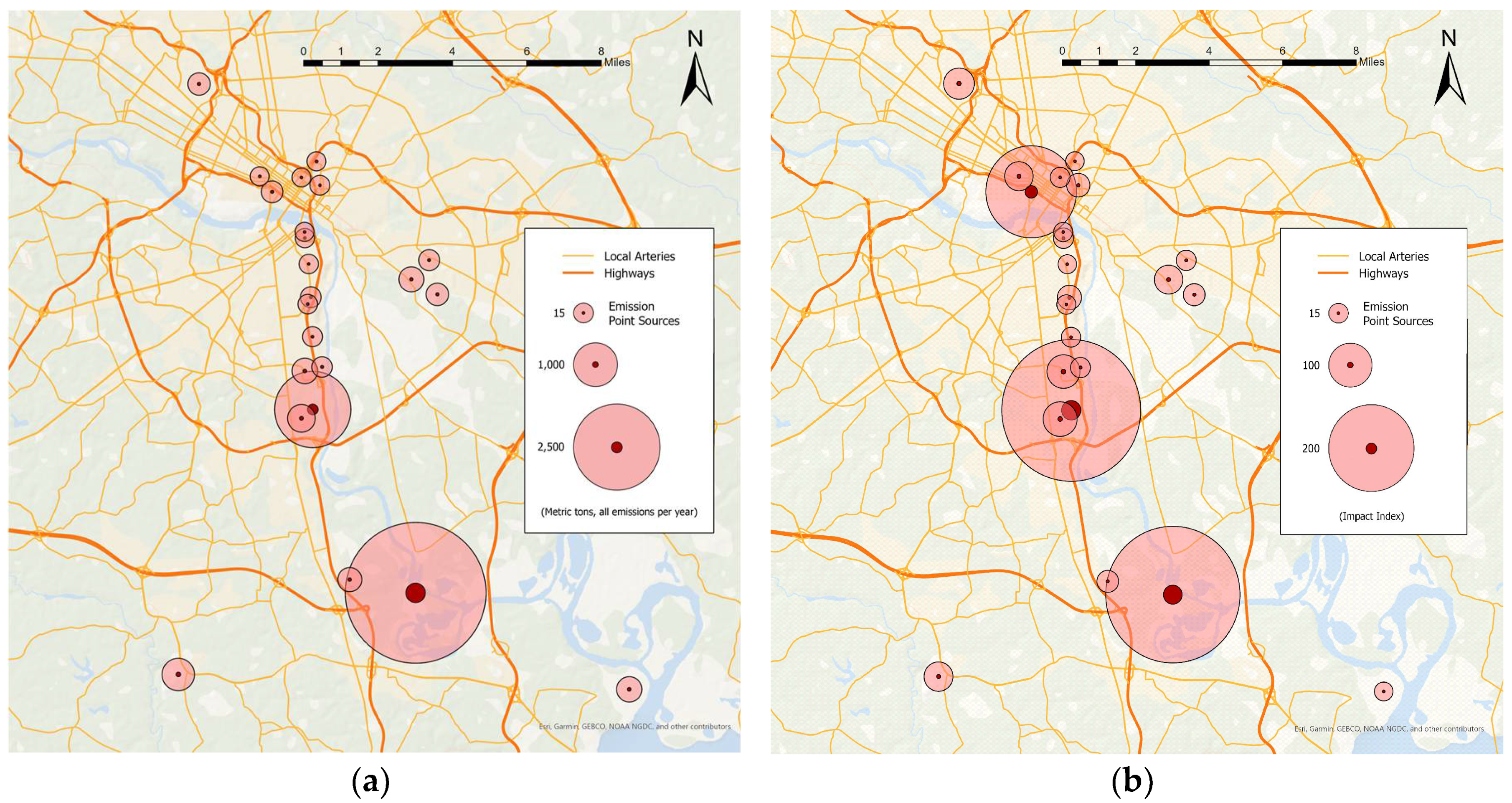

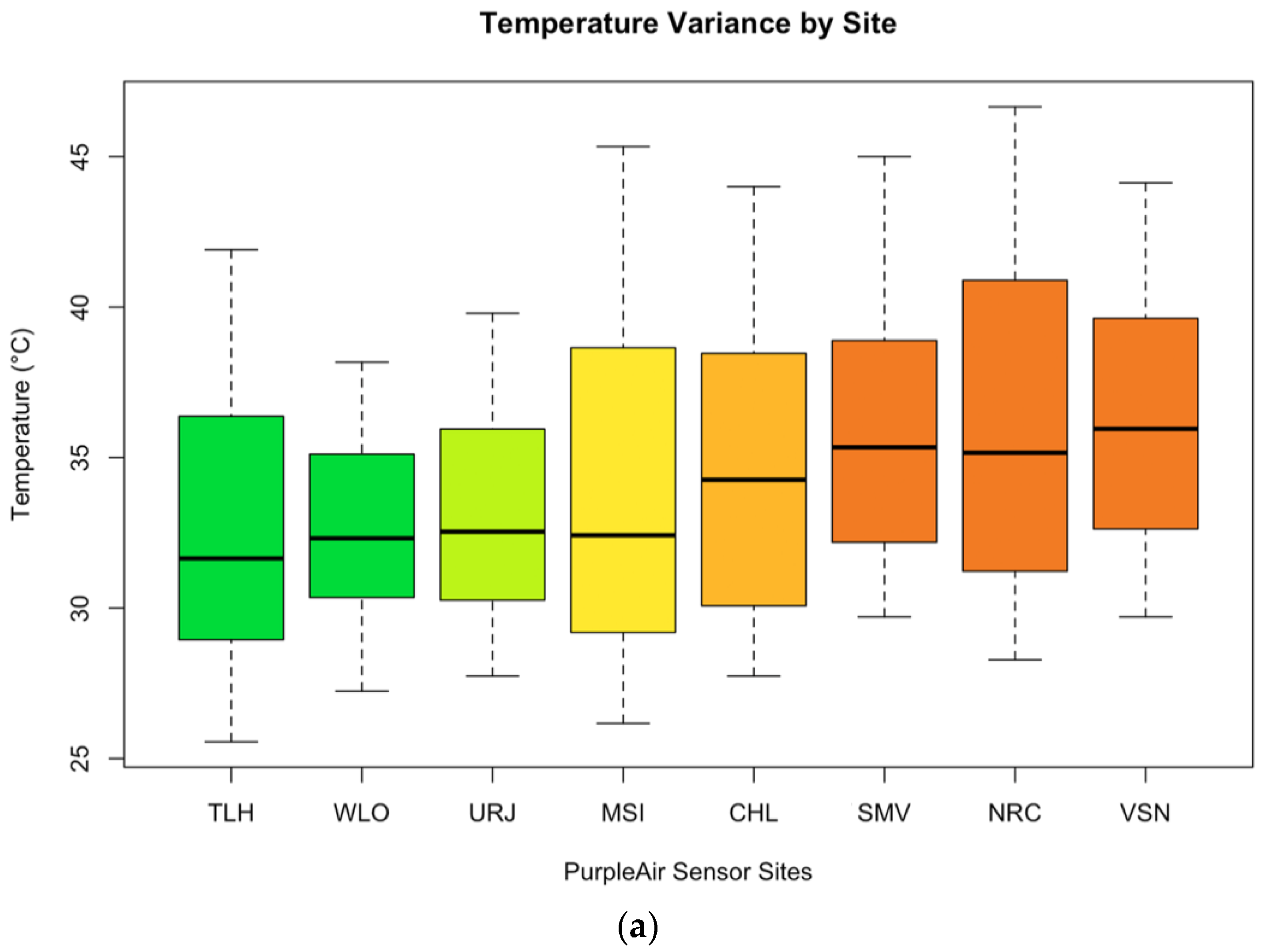
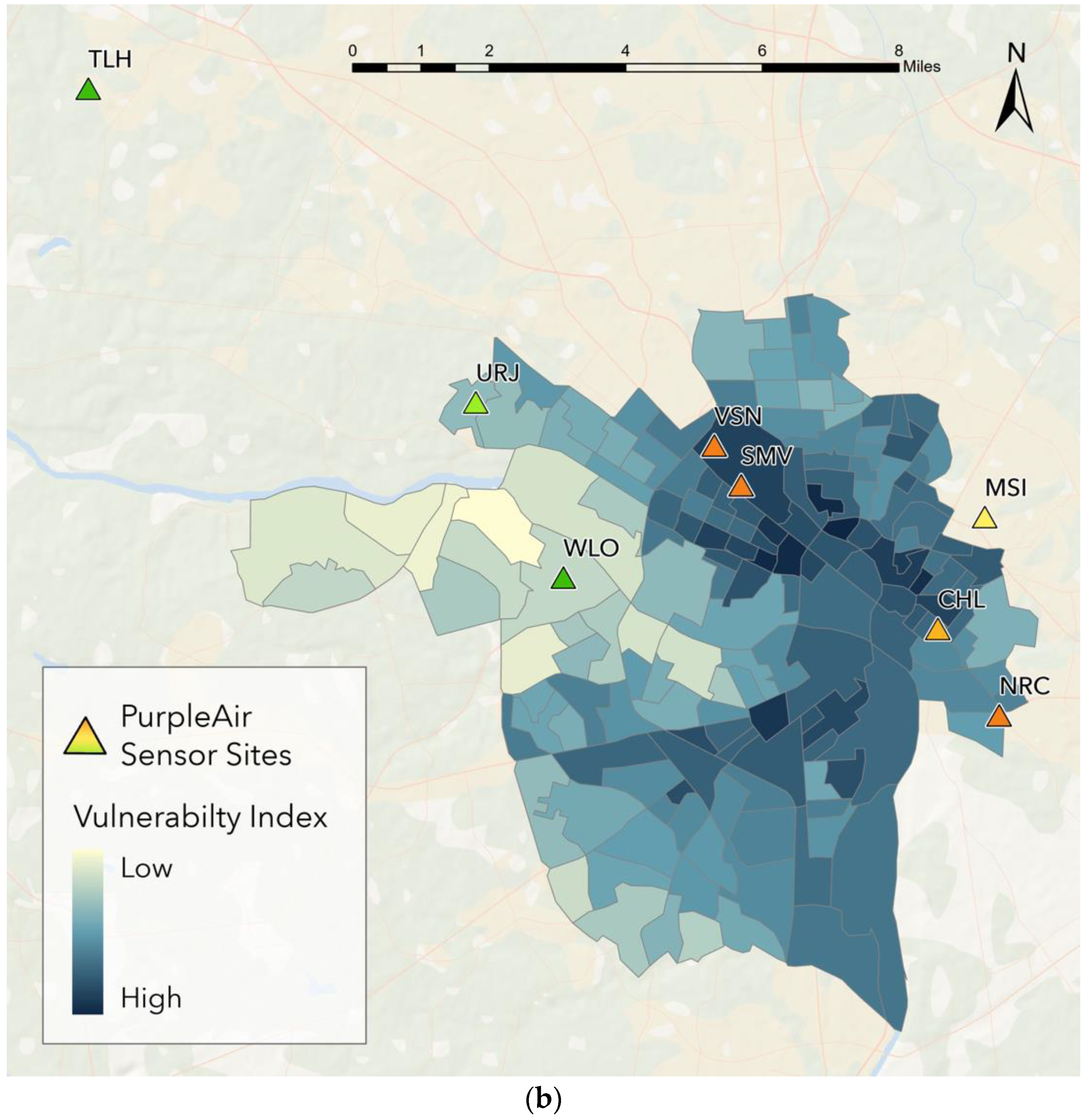
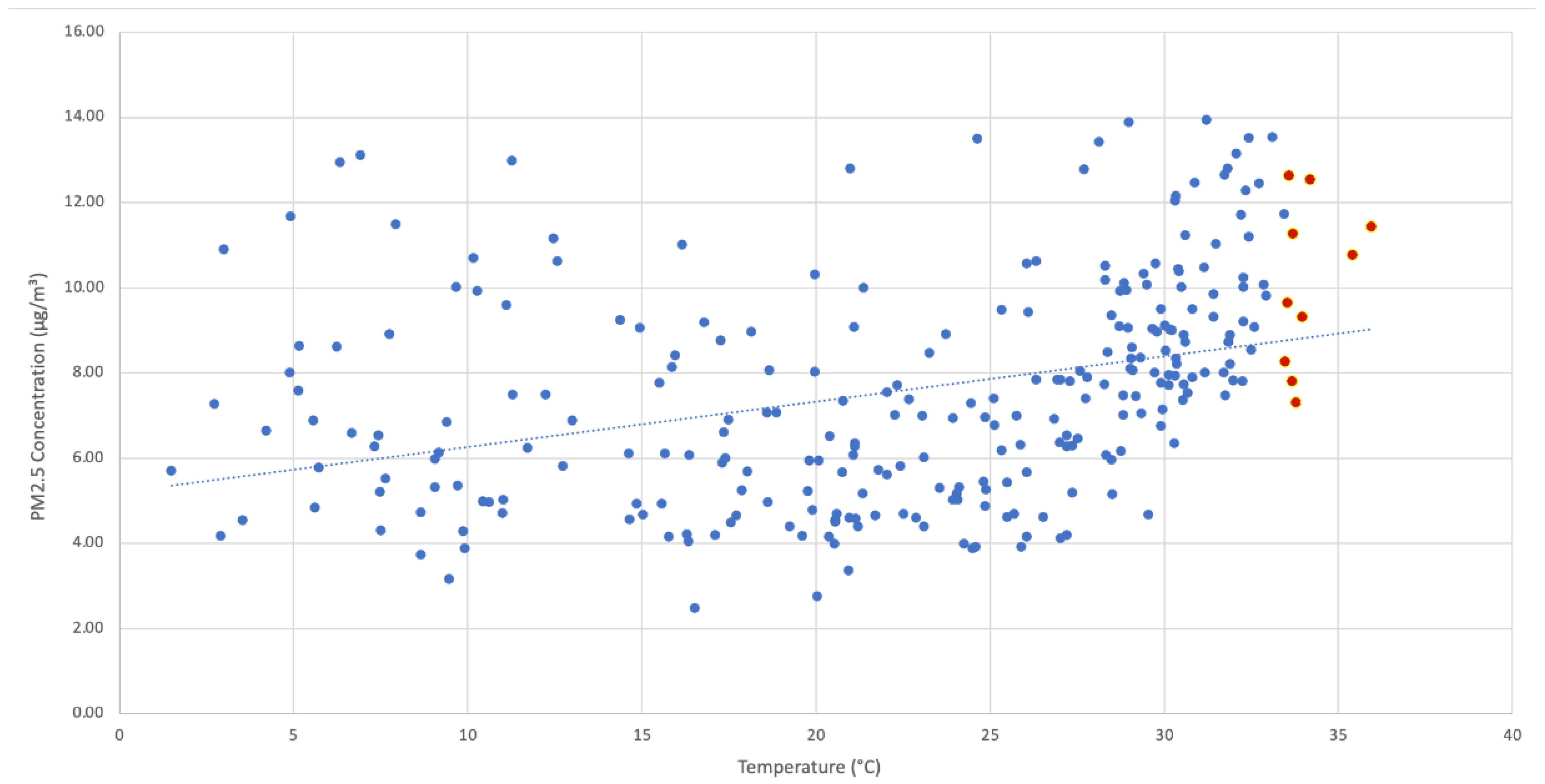
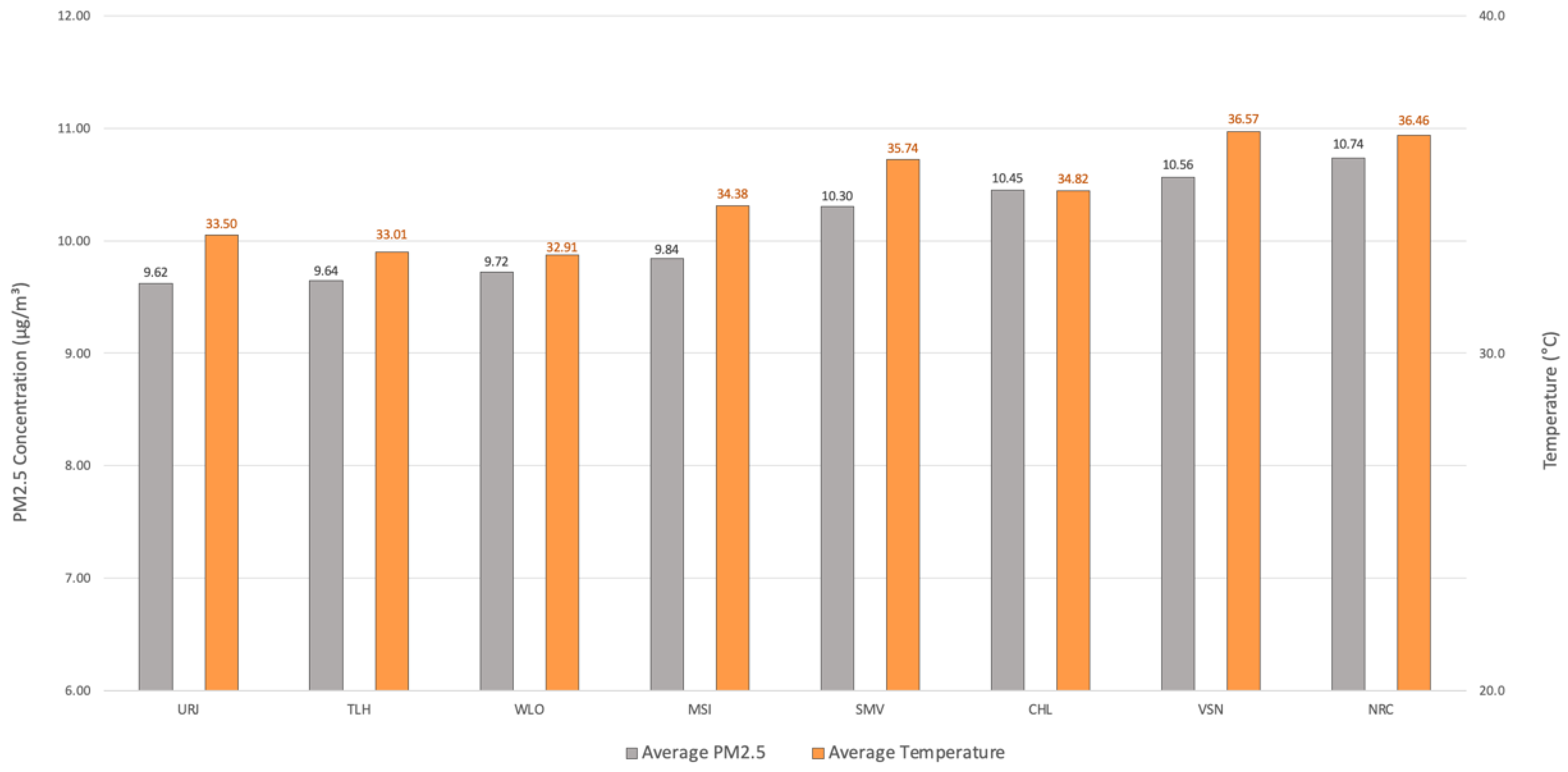

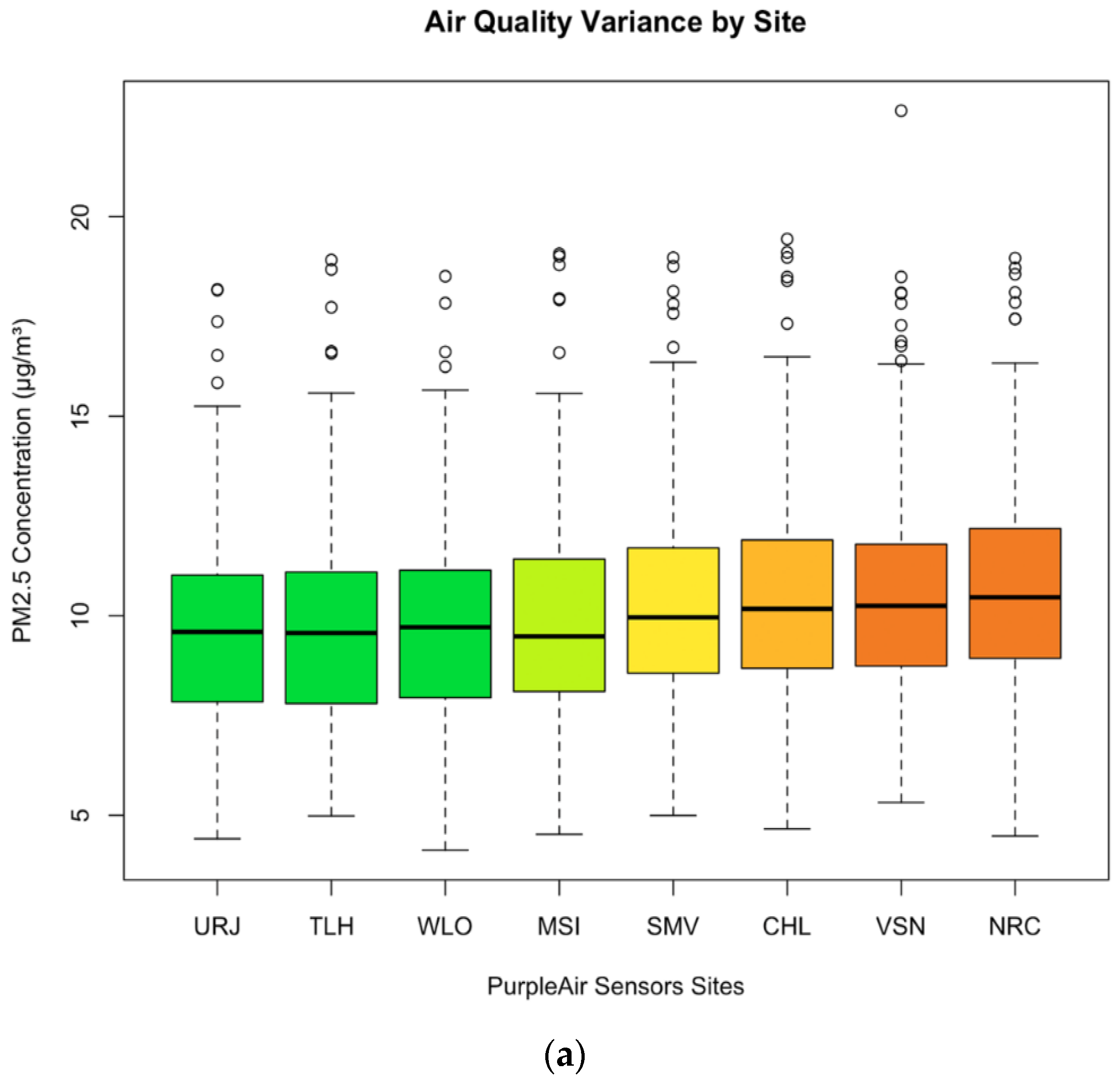
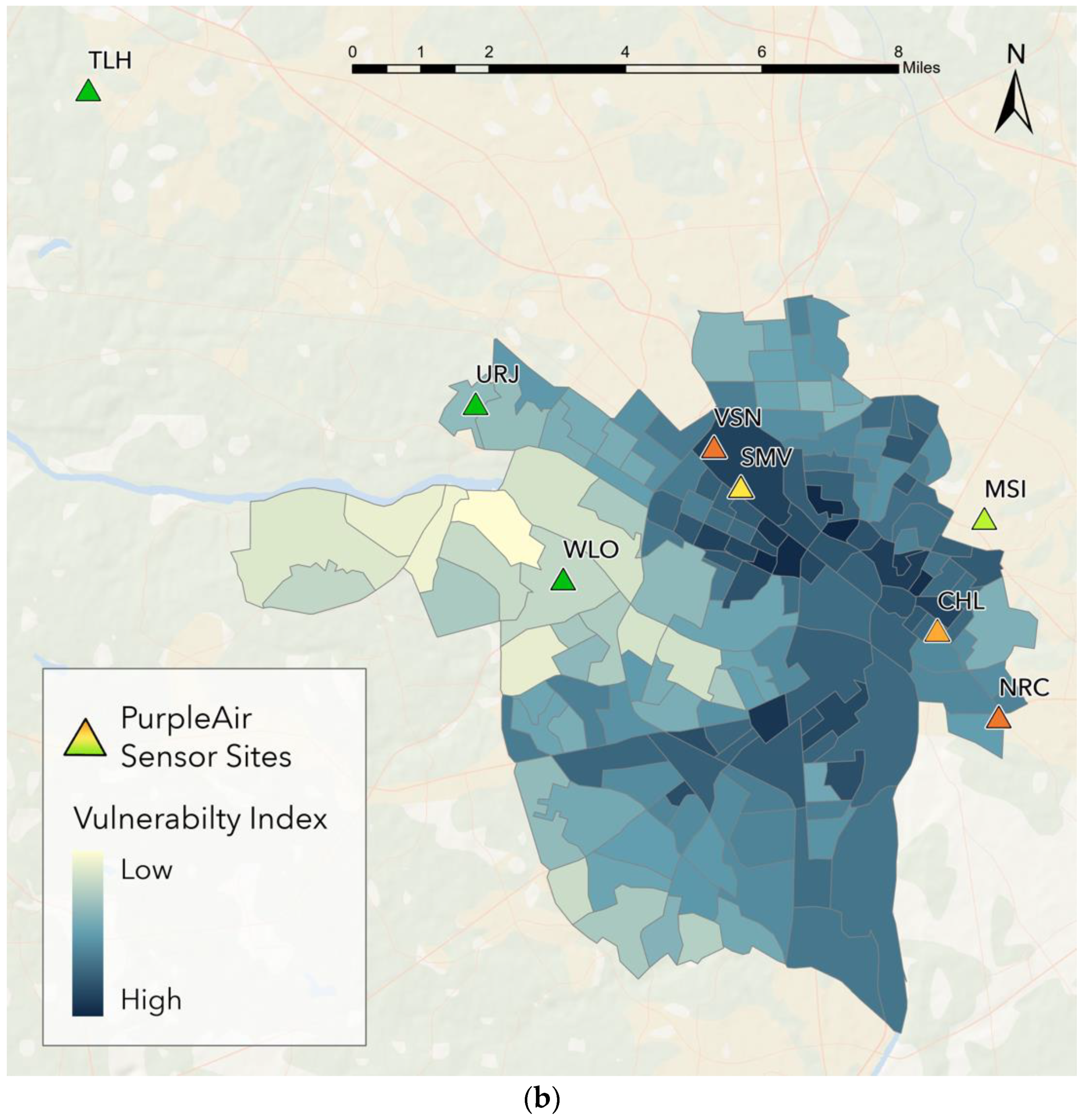
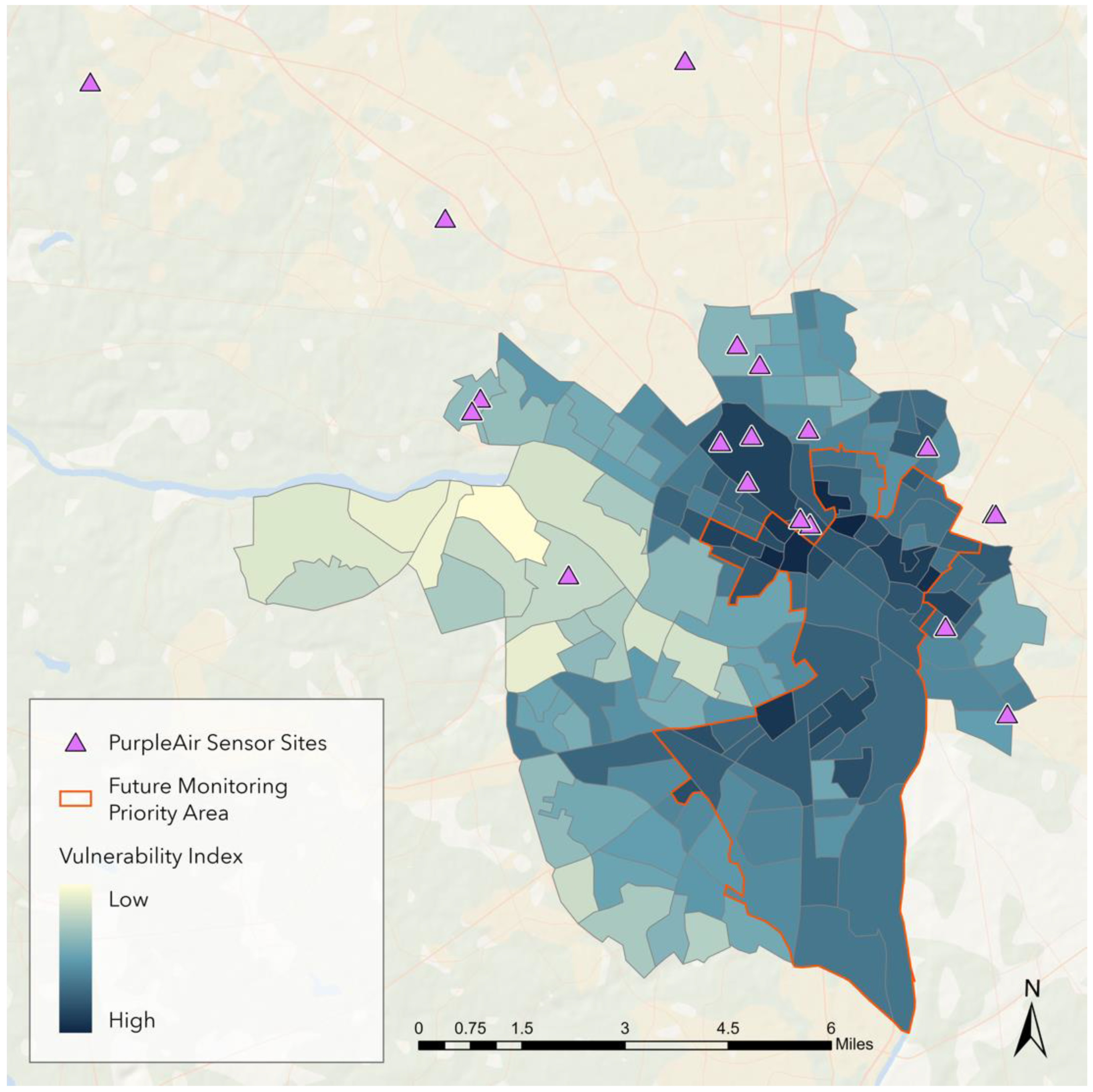
| T640X | MSI A | MSI B | EHN A | |
|---|---|---|---|---|
| EHN B | rho = 0.70 | rho = 0.99 | rho = 0.99 | rho = 0.99 |
| R = 0.69 | R = 0.98 | R = 0.99 | R = 0.99 | |
| Slope = 0.83 | Slope = 1.04 | Slope = 0.97 | Slope = 1.00 | |
| EHN A | rho = 0.69 | rho = 0.99 | rho = 0.99 | |
| R = 0.68 | R = 0.99 | R = 0.97 | ||
| Slope = 0.82 | Slope = 1.04 | Slope = 0.98 | ||
| MSI B | rho = 0.68 | rho = 0.99 | ||
| R = 0.69 | R = 0.99 | |||
| Slope = 0.82 | Slope = 0.97 | |||
| MSI A | rho = 0.68 | |||
| R = 0.67 | ||||
| Slope = 0.85 |
| T640X | MSI A | MSI B | EHN A | |
|---|---|---|---|---|
| EHN B | rho = 0.61 | rho = 0.99 | rho = 0.99 | rho = 1.00 |
| R = 0.53 | R = 0.98 | R = 0.99 | R = 1.00 | |
| Slope = 0.66 | Slope = 1.16 | Slope = 1.06 | Slope = 1.01 | |
| EHN A | rho = 0.61 | rho = 0.99 | rho = 1.00 | |
| R = 0.53 | R = 0.99 | R = 1.00 | ||
| Slope = 0.67 | Slope = 1.14 | Slope = 1.05 | ||
| MSI B | rho = 0.62 | rho = 0.99 | ||
| R = 0.54 | R = 0.99 | |||
| Slope = 0.72 | Slope = 1.08 | |||
| MSI A | rho = 0.62 | |||
| R = 0.54 | ||||
| Slope = 0.78 |
Publisher’s Note: MDPI stays neutral with regard to jurisdictional claims in published maps and institutional affiliations. |
© 2020 by the authors. Licensee MDPI, Basel, Switzerland. This article is an open access article distributed under the terms and conditions of the Creative Commons Attribution (CC BY) license (http://creativecommons.org/licenses/by/4.0/).
Share and Cite
Eanes, A.M.; Lookingbill, T.R.; Hoffman, J.S.; Saverino, K.C.; Fong, S.S. Assessing Inequitable Urban Heat Islands and Air Pollution Disparities with Low-Cost Sensors in Richmond, Virginia. Sustainability 2020, 12, 10089. https://doi.org/10.3390/su122310089
Eanes AM, Lookingbill TR, Hoffman JS, Saverino KC, Fong SS. Assessing Inequitable Urban Heat Islands and Air Pollution Disparities with Low-Cost Sensors in Richmond, Virginia. Sustainability. 2020; 12(23):10089. https://doi.org/10.3390/su122310089
Chicago/Turabian StyleEanes, Andre M., Todd R. Lookingbill, Jeremy S. Hoffman, Kelly C. Saverino, and Stephen S. Fong. 2020. "Assessing Inequitable Urban Heat Islands and Air Pollution Disparities with Low-Cost Sensors in Richmond, Virginia" Sustainability 12, no. 23: 10089. https://doi.org/10.3390/su122310089
APA StyleEanes, A. M., Lookingbill, T. R., Hoffman, J. S., Saverino, K. C., & Fong, S. S. (2020). Assessing Inequitable Urban Heat Islands and Air Pollution Disparities with Low-Cost Sensors in Richmond, Virginia. Sustainability, 12(23), 10089. https://doi.org/10.3390/su122310089







